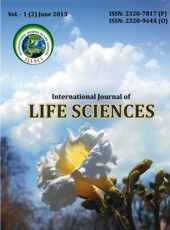Macrophytes as a heavy metal scavengers at MIDC effluent stream
Keywords:
Heavy metals, Pollution, Linn, Zinc, PhytoremediationAbstract
Environmental heavy metal pollution is mainly of anthropogenic. Heavy metals are ubiquitous environmental contaminants in industrialized societies. Most plants are able to accumulate heavy metals from water and soil. In present study investigation was made on Croton tiglium Linn., Sonchus oleraceus Linn., Argemone mexicana Linn., Alocasia (Schott) G. Don and Cyperus Linn. to evaluate the efficiency of phytoremediation. Results revealed that among the heavy metals studied viz. Cadmium, Mercury and Zinc efficient system for phytoremediation is Croton tiglium Linn. and Sonchus oleraceus Linn. Results also conclude that the order of sensitivity of heavy metals studied towards the five plants is Zinc > Cadmium > Mercury.
Downloads
References
1. Ab-Aziz Abdul Latiff, Ahmad Tarmizi Abd Karim, Ahmad Shukri Ahmad, Mohd Baharudin Ridzuan, Yung-Tse Hung (2012) Phytoremediation of Metals in Industrial Sludge by Cyperus kyllingia-Rasiga, Asystassia intrusa and Scindapsus pictus Var Argyaeus Plant Species. Int. J. Of Integrated Engineering, 4(2): 1-8.
2. Agunbiade FO and Fawale AT (2009) Phytoremediation potential of Eicchornia crassipes in metalcontaminated coastal water. Bioresource Technology, 100: 4521-4526.
3. Alloway BJ (1995) Soil processes and the behaviour of metals. In: Alloway BJ (ed) Heavy metals in soils, Blackie and Sons Limited, Glasgow pp. 1-52.
4. Black H (1995) Absorbing possibilities: Phytoremediation. Environ. Health Perspectives, 103(12): 1106–1108.
5. Chen XC, Wang YP, Lin Q, Shi JY, Wu WX, Chen YX (2005) Biosorption of copper (II) and zinc (II) from aqueous solution by Pseudomonas putida CZ1. Colloids and Surfaces B: Biointerfaces, 46: 101-107.
6. Diels N, Van der Lelie D, Bastiaens L (2002) New developments in treatment of heavy metal contaminated soils. Re/Views in Environ. Sci. & Bio/Technol, 1: 75–82.
7. Dunbabin JS and Bowmer KH (1992) Potential use of constructed wetlands for treatment of industrial wastewaters containing metals. Sci. Total Environ, 111: 151-168.
8. Gottardini E, Cristofolini F, Paoletti E, Paolo Lazzeri P, Pepponi G (2004) Pollen Viability for Air Pollution BioMonitoring. Journal of Atmospheric Chemistry, 49: 149-159.
9. Khairia M and Al-Qahtani (2012) Assessment of Heavy Metals Accumulation in Native Plant Species from Soils Contaminated in Riyadh City, Saudi Arabia. Life Sci J, 9(2): 384-392
10. Malik A (2004) Metal bioremediation through growing cells. Environment International, 30: 261-278.
11. Nyangababo JT, Henry E, Omutange E (2005) Lead, cadmium, copper, manganese and zinc in wetland waters of Victoria lake basin, East Africa, Bull. Environ. Contam. Toxicol., 74(5): 1003-1010.
12. Sinicrope TL, Langis R, Gersberg RM, Busnardo MJ, Zedler JB (1992) Metal removal by wetland mesocosms subjected to different hydroperiods. Ecol. Eng, 1: 309-322.
Downloads
Published
How to Cite
Issue
Section
License
Copyright (c) 2013 Authors

This work is licensed under a Creative Commons Attribution-NonCommercial-NoDerivatives 4.0 International License.
Open Access This article is licensed under a Creative Commons Attribution 4.0 International License, which permits use, sharing, adaptation, distribution and reproduction in any medium or format, as long as you give appropriate credit to the original author(s) and the source, provide a link to the Creative Commons license, and indicate if changes were made. The images or other third party material in this article are included in the article’s Creative Commons license unless indicated otherwise in a credit line to the material. If the material is not included in the article’s Creative Commons license and your intended use is not permitted by statutory regulation or exceeds the permitted use, you will need to obtain permission directly from the copyright holder. To view a copy of this license, visit http://creativecommons.org/ licenses/by/4.0/











